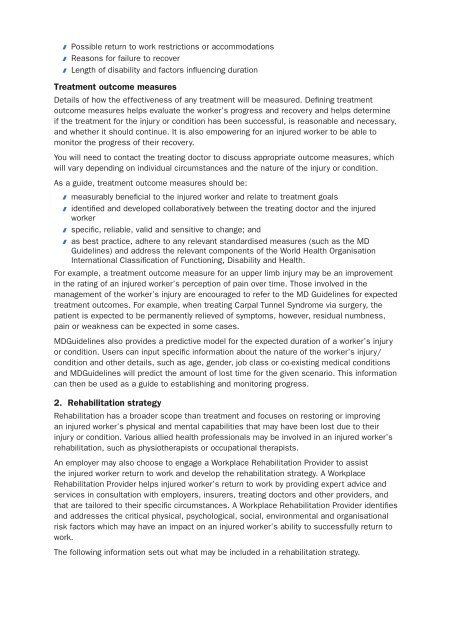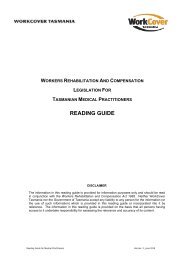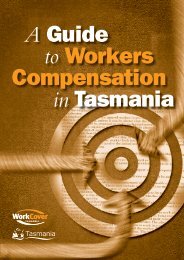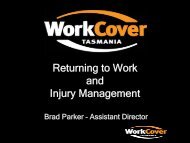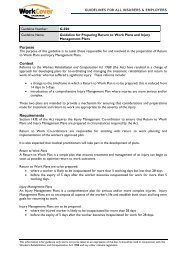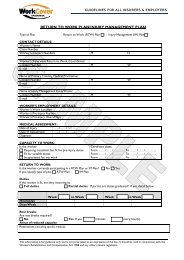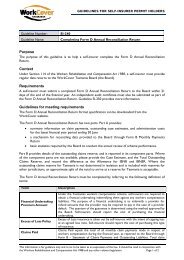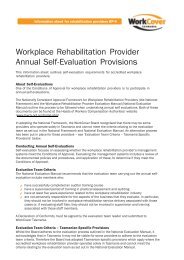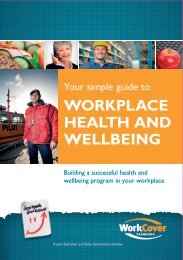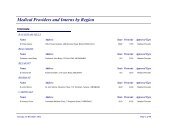Preparing injury management plans - WorkCover Tasmania
Preparing injury management plans - WorkCover Tasmania
Preparing injury management plans - WorkCover Tasmania
Create successful ePaper yourself
Turn your PDF publications into a flip-book with our unique Google optimized e-Paper software.
AAPossible return to work restrictions or accommodationsAAReasons for failure to recoverAALength of disability and factors influencing durationTreatment outcome measuresDetails of how the effectiveness of any treatment will be measured. Defining treatmentoutcome measures helps evaluate the worker’s progress and recovery and helps determineif the treatment for the <strong>injury</strong> or condition has been successful, is reasonable and necessary,and whether it should continue. It is also empowering for an injured worker to be able tomonitor the progress of their recovery.You will need to contact the treating doctor to discuss appropriate outcome measures, whichwill vary depending on individual circumstances and the nature of the <strong>injury</strong> or condition.As a guide, treatment outcome measures should be:AAmeasurably beneficial to the injured worker and relate to treatment goalsAAidentified and developed collaboratively between the treating doctor and the injuredworkerAAspecific, reliable, valid and sensitive to change; andAAas best practice, adhere to any relevant standardised measures (such as the MDGuidelines) and address the relevant components of the World Health OrganisationInternational Classification of Functioning, Disability and Health.For example, a treatment outcome measure for an upper limb <strong>injury</strong> may be an improvementin the rating of an injured worker’s perception of pain over time. Those involved in the<strong>management</strong> of the worker’s <strong>injury</strong> are encouraged to refer to the MD Guidelines for expectedtreatment outcomes. For example, when treating Carpal Tunnel Syndrome via surgery, thepatient is expected to be permanently relieved of symptoms, however, residual numbness,pain or weakness can be expected in some cases.MDGuidelines also provides a predictive model for the expected duration of a worker’s <strong>injury</strong>or condition. Users can input specific information about the nature of the worker’s <strong>injury</strong>/condition and other details, such as age, gender, job class or co-existing medical conditionsand MDGuidelines will predict the amount of lost time for the given scenario. This informationcan then be used as a guide to establishing and monitoring progress.2. Rehabilitation strategyRehabilitation has a broader scope than treatment and focuses on restoring or improvingan injured worker’s physical and mental capabilities that may have been lost due to their<strong>injury</strong> or condition. Various allied health professionals may be involved in an injured worker’srehabilitation, such as physiotherapists or occupational therapists.An employer may also choose to engage a Workplace Rehabilitation Provider to assistthe injured worker return to work and develop the rehabilitation strategy. A WorkplaceRehabilitation Provider helps injured worker’s return to work by providing expert advice andservices in consultation with employers, insurers, treating doctors and other providers, andthat are tailored to their specific circumstances. A Workplace Rehabilitation Provider identifiesand addresses the critical physical, psychological, social, environmental and organisationalrisk factors which may have an impact on an injured worker’s ability to successfully return towork.The following information sets out what may be included in a rehabilitation strategy.


